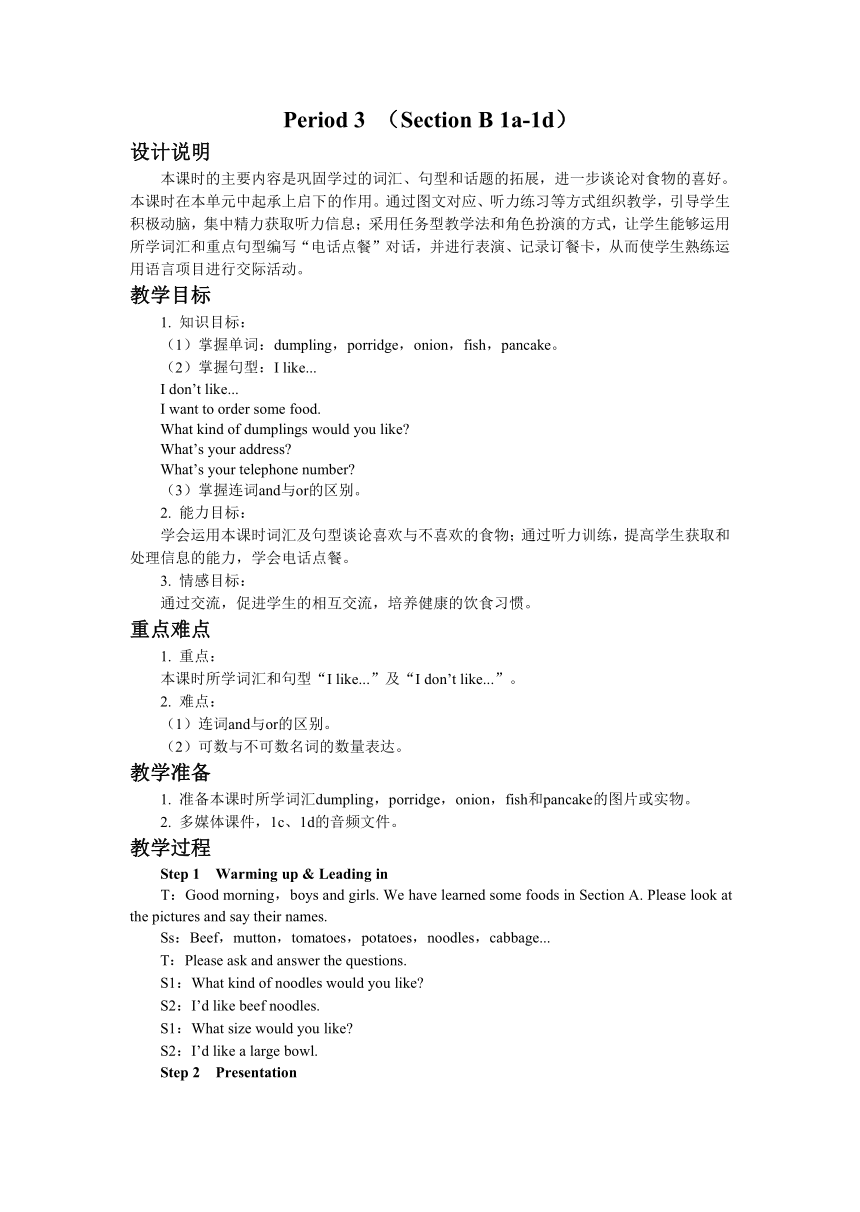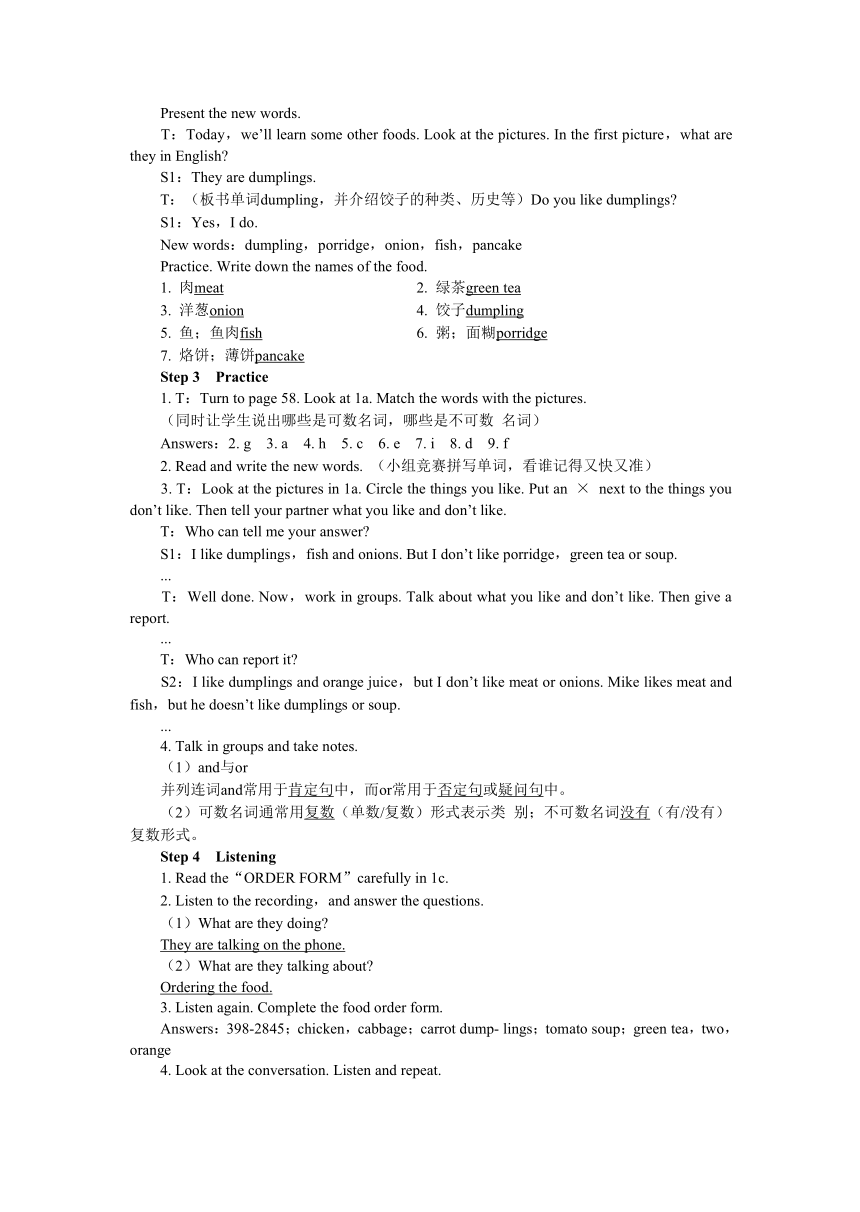教学详案 --人教版中学英语七年级(下)UNIT 10 Period 3 (Section B 1a-1d)
文档属性
| 名称 | 教学详案 --人教版中学英语七年级(下)UNIT 10 Period 3 (Section B 1a-1d) |

|
|
| 格式 | docx | ||
| 文件大小 | 25.7KB | ||
| 资源类型 | 试卷 | ||
| 版本资源 | 人教新目标(Go for it)版 | ||
| 科目 | 英语 | ||
| 更新时间 | 2024-02-21 19:48:23 | ||
图片预览


文档简介
Period 3 (Section B 1a-1d)
设计说明
本课时的主要内容是巩固学过的词汇、句型和话题的拓展,进一步谈论对食物的喜好。本课时在本单元中起承上启下的作用。通过图文对应、听力练习等方式组织教学,引导学生积极动脑,集中精力获取听力信息;采用任务型教学法和角色扮演的方式,让学生能够运用所学词汇和重点句型编写“电话点餐”对话,并进行表演、记录订餐卡,从而使学生熟练运用语言项目进行交际活动。
教学目标
1. 知识目标:
(1)掌握单词:dumpling,porridge,onion,fish,pancake。
(2)掌握句型:I like...
I don’t like...
I want to order some food.
What kind of dumplings would you like
What’s your address
What’s your telephone number
(3)掌握连词and与or的区别。
2. 能力目标:
学会运用本课时词汇及句型谈论喜欢与不喜欢的食物;通过听力训练,提高学生获取和处理信息的能力,学会电话点餐。
3. 情感目标:
通过交流,促进学生的相互交流,培养健康的饮食习惯。
重点难点
1. 重点:
本课时所学词汇和句型“I like...”及“I don’t like...”。
2. 难点:
(1)连词and与or的区别。
(2)可数与不可数名词的数量表达。
教学准备
1. 准备本课时所学词汇dumpling,porridge,onion,fish和pancake的图片或实物。
2. 多媒体课件,1c、1d的音频文件。
教学过程
Step 1 Warming up & Leading in
T:Good morning,boys and girls. We have learned some foods in Section A. Please look at the pictures and say their names.
Ss:Beef,mutton,tomatoes,potatoes,noodles,cabbage...
T:Please ask and answer the questions.
S1:What kind of noodles would you like
S2:I’d like beef noodles.
S1:What size would you like
S2:I’d like a large bowl.
Step 2 Presentation
Present the new words.
T:Today,we’ll learn some other foods. Look at the pictures. In the first picture,what are they in English
S1:They are dumplings.
T:(板书单词dumpling,并介绍饺子的种类、历史等)Do you like dumplings
S1:Yes,I do.
New words:dumpling,porridge,onion,fish,pancake
Practice. Write down the names of the food.
1. 肉meat 2. 绿茶green tea
3. 洋葱onion 4. 饺子dumpling
5. 鱼;鱼肉fish 6. 粥;面糊porridge
7. 烙饼;薄饼pancake
Step 3 Practice
1. T:Turn to page 58. Look at 1a. Match the words with the pictures.
(同时让学生说出哪些是可数名词,哪些是不可数 名词)
Answers:2. g 3. a 4. h 5. c 6. e 7. i 8. d 9. f
2. Read and write the new words. (小组竞赛拼写单词,看谁记得又快又准)
3. T:Look at the pictures in 1a. Circle the things you like. Put an × next to the things you don’t like. Then tell your partner what you like and don’t like.
T:Who can tell me your answer
S1:I like dumplings,fish and onions. But I don’t like porridge,green tea or soup.
...
T:Well done. Now,work in groups. Talk about what you like and don’t like. Then give a report.
...
T:Who can report it
S2:I like dumplings and orange juice,but I don’t like meat or onions. Mike likes meat and fish,but he doesn’t like dumplings or soup.
...
4. Talk in groups and take notes.
(1)and与or
并列连词and常用于肯定句中,而or常用于否定句或疑问句中。
(2)可数名词通常用复数(单数/复数)形式表示类 别;不可数名词没有(有/没有)复数形式。
Step 4 Listening
1. Read the“ORDER FORM”carefully in 1c.
2. Listen to the recording,and answer the questions.
(1)What are they doing
They are talking on the phone.
(2)What are they talking about
Ordering the food.
3. Listen again. Complete the food order form.
Answers:398-2845;chicken,cabbage;carrot dump- lings;tomato soup;green tea,two,orange
4. Look at the conversation. Listen and repeat.
5. Work in groups. Talk and fill in the blanks.
电话订餐常用语:
(1)Can I help you = What can I do for you = What would you like 您想要什么?
(2)I want to order some food. 我想订一些食物。
(3)What kind of dumplings/soup...would you like
您想要哪种饺子/汤……?
(4)How many/much...do you want
您想要多少……?
(5)Would you like some drinks 您想要些饮料吗?
(6)What else 还要什么吗?
(7)What’s your address 您的地址是什么?
(8)What’s your telephone number
您的电话号码是什么?
Step 5 Pair work
T:Look at the screen. Here is a task. You need to call the restaurant to order food. Now work in groups.
Student A is the waiter/waitress;Student B is the customer. Student B calls Student A to order some food. Make a conversation with the expressions given below:
House of Dumplings.
Can I help you /What would you like
I want to order...
How many dumplings do you want
What kind of dumplings would you like
Would you like some drinks What else
What’s your address
What’s your telephone number
(Give them enough time to prepare.)
Check three or four groups.
Step 6 Summary
In this lesson,we have learned:
1. New words:dumpling,porridge,onion,fish,pancake
2. Sentence structures:I like...
I don’t like...
I want to order some food.
What kind of dumplings would you like
What’s your address
What’s your telephone number
当堂达标(见导学案“当堂达标”)
答案与解析:
Ⅰ. 1. to order would like to do sth. 意为“想要做某事”。
2. dumplings dumpling是可数名词,其复数形式为dumplings。
3. meat meat是不可数名词,what kind of meat意为“哪种肉”。
4. porridge porridge是不可数名词,没有复数形式。
5. pancakes 根据下句中的them判断,此处用pancake的复数形式pancakes。
Ⅱ. 1. A “Would you like sth. ”是表示提建议的一般疑问句,在此句中表示“一些”用some。
2. C bananas为可数名词复数,其后的be动词应用are;mutton为不可数名词,其后的be动词应用is。
3. A 根据句意可知此处应填表示并列的连词,且该句是否定句,故用or。
4. B “Would you like sth. ”句型的肯定答语常用“Yes,please. ”;否定答语常用“No,thanks.”。根据答语后句句意“我非常口渴”可知应为肯定答语。
5. B 根据答语句意“我想要一些果汁”推断,问句应是问“你想要什么?”,故选B。
Ⅲ. 1. B 2. F 3. D 4. A 5. E
Ⅳ. 1. B 由第一则广告中的价格可知小份甜点10元,中份甜点12元,大份甜点15元。你如果有30元钱,可以买到两种甜点。
2. C 由第一则广告可知大份甜点15元,由第二则广告可知两个小碗羊肉胡萝卜面(2.5×2=)5元,一个大碗西红柿鸡蛋面3元,共计23元。
3. C 由第一则广告可知,仅有small dessert中没有土豆或西红柿,故Nancy可以吃小份甜点。
4. D 问题中介绍Emma想要一小碗面条,但是不吃鸡蛋和牛肉,故排除A、C两项;B项中大碗的鸡肉卷心菜面是4元钱,小碗的羊肉胡萝卜面是2.5元钱,加在一起为6.5元钱,超过6元,故排除;D项中大碗的牛肉土豆面是4元钱,小碗的鸡肉卷心菜面是2元钱,加在一起为6元钱。故选D。
5. A 这两则广告主要是关于不同食物的,故选A。
Step 7 Homework
1. Make notes about the countable nouns and uncountable nouns and remember them.
2. Make notes about the useful expressions about ordering food and remember them.
3. Prepare 2a and 2b before class.
板书设计
UNIT 10 I’d like some noodles. Period 3 (Section B 1a-1d)
countable nouns: dumpling(s),pancake(s) uncountable nouns:porridge countable and uncountable nouns:onion,fish What would you like What kind of...would you like What size would you like Would you like some... What else What’s your address/telephone number
教学反思
设计说明
本课时的主要内容是巩固学过的词汇、句型和话题的拓展,进一步谈论对食物的喜好。本课时在本单元中起承上启下的作用。通过图文对应、听力练习等方式组织教学,引导学生积极动脑,集中精力获取听力信息;采用任务型教学法和角色扮演的方式,让学生能够运用所学词汇和重点句型编写“电话点餐”对话,并进行表演、记录订餐卡,从而使学生熟练运用语言项目进行交际活动。
教学目标
1. 知识目标:
(1)掌握单词:dumpling,porridge,onion,fish,pancake。
(2)掌握句型:I like...
I don’t like...
I want to order some food.
What kind of dumplings would you like
What’s your address
What’s your telephone number
(3)掌握连词and与or的区别。
2. 能力目标:
学会运用本课时词汇及句型谈论喜欢与不喜欢的食物;通过听力训练,提高学生获取和处理信息的能力,学会电话点餐。
3. 情感目标:
通过交流,促进学生的相互交流,培养健康的饮食习惯。
重点难点
1. 重点:
本课时所学词汇和句型“I like...”及“I don’t like...”。
2. 难点:
(1)连词and与or的区别。
(2)可数与不可数名词的数量表达。
教学准备
1. 准备本课时所学词汇dumpling,porridge,onion,fish和pancake的图片或实物。
2. 多媒体课件,1c、1d的音频文件。
教学过程
Step 1 Warming up & Leading in
T:Good morning,boys and girls. We have learned some foods in Section A. Please look at the pictures and say their names.
Ss:Beef,mutton,tomatoes,potatoes,noodles,cabbage...
T:Please ask and answer the questions.
S1:What kind of noodles would you like
S2:I’d like beef noodles.
S1:What size would you like
S2:I’d like a large bowl.
Step 2 Presentation
Present the new words.
T:Today,we’ll learn some other foods. Look at the pictures. In the first picture,what are they in English
S1:They are dumplings.
T:(板书单词dumpling,并介绍饺子的种类、历史等)Do you like dumplings
S1:Yes,I do.
New words:dumpling,porridge,onion,fish,pancake
Practice. Write down the names of the food.
1. 肉meat 2. 绿茶green tea
3. 洋葱onion 4. 饺子dumpling
5. 鱼;鱼肉fish 6. 粥;面糊porridge
7. 烙饼;薄饼pancake
Step 3 Practice
1. T:Turn to page 58. Look at 1a. Match the words with the pictures.
(同时让学生说出哪些是可数名词,哪些是不可数 名词)
Answers:2. g 3. a 4. h 5. c 6. e 7. i 8. d 9. f
2. Read and write the new words. (小组竞赛拼写单词,看谁记得又快又准)
3. T:Look at the pictures in 1a. Circle the things you like. Put an × next to the things you don’t like. Then tell your partner what you like and don’t like.
T:Who can tell me your answer
S1:I like dumplings,fish and onions. But I don’t like porridge,green tea or soup.
...
T:Well done. Now,work in groups. Talk about what you like and don’t like. Then give a report.
...
T:Who can report it
S2:I like dumplings and orange juice,but I don’t like meat or onions. Mike likes meat and fish,but he doesn’t like dumplings or soup.
...
4. Talk in groups and take notes.
(1)and与or
并列连词and常用于肯定句中,而or常用于否定句或疑问句中。
(2)可数名词通常用复数(单数/复数)形式表示类 别;不可数名词没有(有/没有)复数形式。
Step 4 Listening
1. Read the“ORDER FORM”carefully in 1c.
2. Listen to the recording,and answer the questions.
(1)What are they doing
They are talking on the phone.
(2)What are they talking about
Ordering the food.
3. Listen again. Complete the food order form.
Answers:398-2845;chicken,cabbage;carrot dump- lings;tomato soup;green tea,two,orange
4. Look at the conversation. Listen and repeat.
5. Work in groups. Talk and fill in the blanks.
电话订餐常用语:
(1)Can I help you = What can I do for you = What would you like 您想要什么?
(2)I want to order some food. 我想订一些食物。
(3)What kind of dumplings/soup...would you like
您想要哪种饺子/汤……?
(4)How many/much...do you want
您想要多少……?
(5)Would you like some drinks 您想要些饮料吗?
(6)What else 还要什么吗?
(7)What’s your address 您的地址是什么?
(8)What’s your telephone number
您的电话号码是什么?
Step 5 Pair work
T:Look at the screen. Here is a task. You need to call the restaurant to order food. Now work in groups.
Student A is the waiter/waitress;Student B is the customer. Student B calls Student A to order some food. Make a conversation with the expressions given below:
House of Dumplings.
Can I help you /What would you like
I want to order...
How many dumplings do you want
What kind of dumplings would you like
Would you like some drinks What else
What’s your address
What’s your telephone number
(Give them enough time to prepare.)
Check three or four groups.
Step 6 Summary
In this lesson,we have learned:
1. New words:dumpling,porridge,onion,fish,pancake
2. Sentence structures:I like...
I don’t like...
I want to order some food.
What kind of dumplings would you like
What’s your address
What’s your telephone number
当堂达标(见导学案“当堂达标”)
答案与解析:
Ⅰ. 1. to order would like to do sth. 意为“想要做某事”。
2. dumplings dumpling是可数名词,其复数形式为dumplings。
3. meat meat是不可数名词,what kind of meat意为“哪种肉”。
4. porridge porridge是不可数名词,没有复数形式。
5. pancakes 根据下句中的them判断,此处用pancake的复数形式pancakes。
Ⅱ. 1. A “Would you like sth. ”是表示提建议的一般疑问句,在此句中表示“一些”用some。
2. C bananas为可数名词复数,其后的be动词应用are;mutton为不可数名词,其后的be动词应用is。
3. A 根据句意可知此处应填表示并列的连词,且该句是否定句,故用or。
4. B “Would you like sth. ”句型的肯定答语常用“Yes,please. ”;否定答语常用“No,thanks.”。根据答语后句句意“我非常口渴”可知应为肯定答语。
5. B 根据答语句意“我想要一些果汁”推断,问句应是问“你想要什么?”,故选B。
Ⅲ. 1. B 2. F 3. D 4. A 5. E
Ⅳ. 1. B 由第一则广告中的价格可知小份甜点10元,中份甜点12元,大份甜点15元。你如果有30元钱,可以买到两种甜点。
2. C 由第一则广告可知大份甜点15元,由第二则广告可知两个小碗羊肉胡萝卜面(2.5×2=)5元,一个大碗西红柿鸡蛋面3元,共计23元。
3. C 由第一则广告可知,仅有small dessert中没有土豆或西红柿,故Nancy可以吃小份甜点。
4. D 问题中介绍Emma想要一小碗面条,但是不吃鸡蛋和牛肉,故排除A、C两项;B项中大碗的鸡肉卷心菜面是4元钱,小碗的羊肉胡萝卜面是2.5元钱,加在一起为6.5元钱,超过6元,故排除;D项中大碗的牛肉土豆面是4元钱,小碗的鸡肉卷心菜面是2元钱,加在一起为6元钱。故选D。
5. A 这两则广告主要是关于不同食物的,故选A。
Step 7 Homework
1. Make notes about the countable nouns and uncountable nouns and remember them.
2. Make notes about the useful expressions about ordering food and remember them.
3. Prepare 2a and 2b before class.
板书设计
UNIT 10 I’d like some noodles. Period 3 (Section B 1a-1d)
countable nouns: dumpling(s),pancake(s) uncountable nouns:porridge countable and uncountable nouns:onion,fish What would you like What kind of...would you like What size would you like Would you like some... What else What’s your address/telephone number
教学反思
同课章节目录
- Unit 1 Can you play the guitar?
- Section A
- Section B
- Unit 2 What time do you go to school?
- Section A
- Section B
- Unit 3 How do you get to school?
- Section A
- Section B
- Unit 4 Don't eat in class.
- Section A
- Section B
- Unit 5 Why do you like pandas?
- Section A
- Section B
- Unit 6 I'm watching TV.
- Section A
- Section B
- Review of Units 1-6
- Unit 7 It's raining!
- Section A
- Section B
- Unit 8 Is there a post office near here?
- Section A
- Section B
- Unit 9 What does he look like?
- Section A
- Section B
- Unit 10 I'd like some noodles.
- Section A
- Section B
- Unit 11 How was your school trip?
- Section A
- Section B
- Unit 12 What did you do last weekend?
- Section A
- Section B
